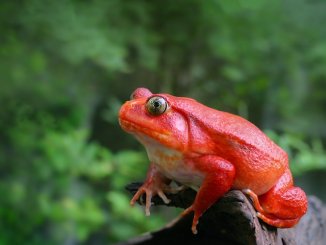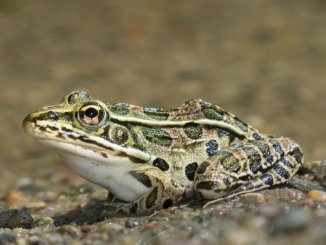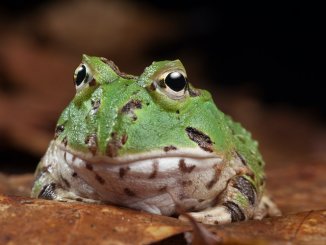The black rain frog is known for its puffy shape and unyielding frown. It comes from the mountain slopes along the southern coast of South Africa.
Black rain frogs are low maintenance, but setting up an environment for them is usually difficult. They’re burrowers, spending most of their day in burrows that are up to eight inches deep.
It’s important to note that black rain frogs are not typical pets. They’re a wild frog isolated to a single region of South Africa that isn’t known for its amphibian trade. People have no incentive to capture and export black rain frogs, making their availability in the pet trade nonexistent.
Black Rain Frog Overview
| Common Name(s) | Black rain frog, plain rain frog, brown short-headed frog, Tsitsikamma rain frog |
| Scientific Name | Breviceps fuscus |
| Natural Habitat | South Africa, specifically in the southwestern portion of the country on the slopes of the Cape Fold Belt at elevations above 3,300 feet |
| Adult Size | Up to 2 inches |
| Average Lifespan | 4–15 years |
| Diet | Carnivore—mainly insects and larvae |
| Housing | Minimum 10-gallon tank size per frog, no open water necessary. |
| Experience Level | Intermediate |
Origin
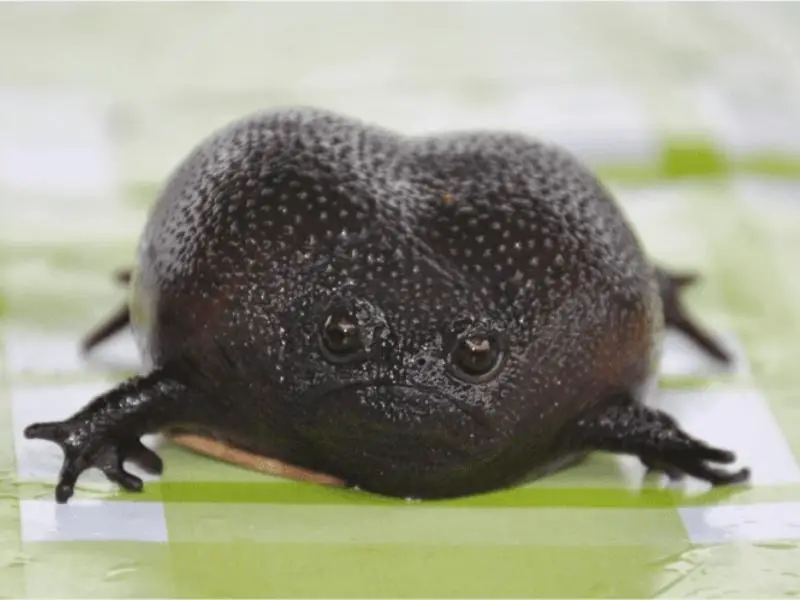
The black rain frog (Breviceps fuscus) is also known as the Tsitsikamma rain frog. It is a species of frog that is part of the Brevicipitidae family.
Black rain frogs can be found solely along the southwestern coast of South Africa. They thrive in the temperate Mediterranean climate of the Cape Fold Mountains. The name Tsitsikamma stems from Tsitsikamma National Park, an area where this frog can be found.
Only residing in areas above 3,300 feet elevation, black rain frogs don’t require the presence of any open water to survive.
Instead, the black rain frog can burrow and spends most of its life underground. It’s also nocturnal, meaning it sleeps in its burrow during the day and comes out to scavenge at night.
Appearance and Behavior
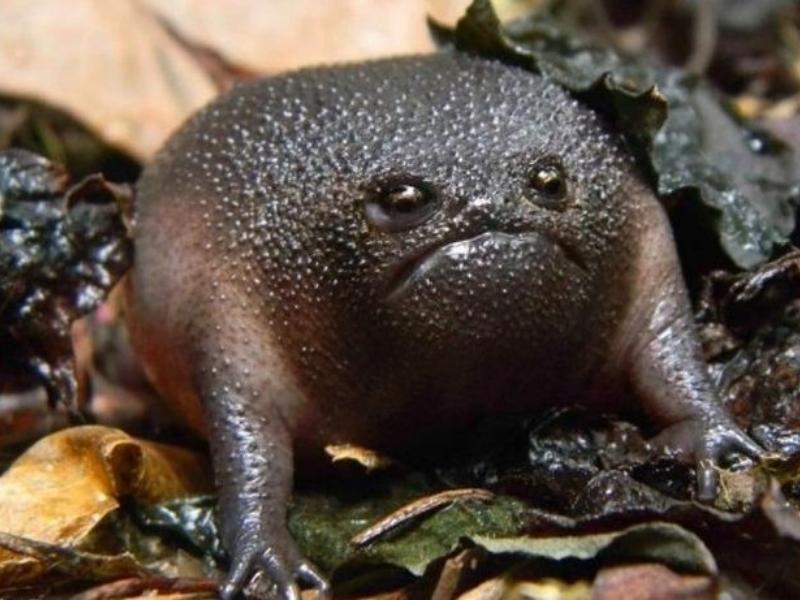
Take one glance at the black rain frog, and you will notice its balloon-like shape, dark black color, and notable frown. Its skin is bumpy and slick to the touch.
The black rain frog’s puffy shape is an evolutionary trait. These frogs use the ability to puff up as a defense mechanism. When in danger, they fill up with air to appear bigger in an attempt to ward off predators like bush pigs, birds, and snakes.
Male black rain frogs tend to be smaller than females. You’ll notice the biggest difference between males and females during reproduction, where females will secrete a sticky substance on their backs for males to latch on to.
Size and Lifespan
Black rain frogs are small, reaching up to only 2 inches in snout to vent length when fully grown. In the wild, they can live between 4–15 years old. Their lifespan varies depending on the number of predators in the area,
According to the International Union for Conservation of Nature (IUCN), the black rain frog is classified as a “least concern” species, meaning they are abundant in the wild and not at threat of becoming endangered.
Expect them to live for at least four years in captivity, provided the rain frog’s enclosure is set up to ideal conditions.
Temperament
Black rain frogs are peaceful and get frightened easily. Male and female black rain frogs enjoy each other’s company, but they shouldn’t be housed together unless you intend on breeding your frogs.
These frogs will fill their lungs up with air, puff out their bodies, and then let out a high-pitched scream when they feel threatened or in danger. Although it’s unclear why black rain frogs puff their bodies out, experts assume frogs do this to adopt a more intimidating look that’ll scare off predators.
Because black rain frogs scare easily, you should keep black rain frogs in a calm, quiet room and handle the frog gently to prevent distress.
Housing Black Rain Frogs
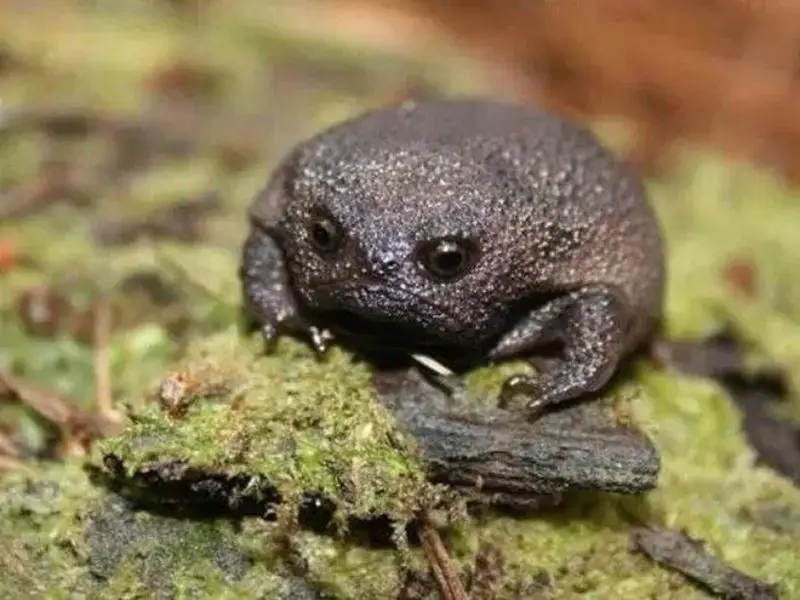
Black rain frogs can be housed in a terrarium or vivarium. An aquarium isn’t necessary since you won’t need to provide them with any open water.
No matter which enclosure you choose, it’s important to provide black rain frogs with an ecosystem similar to their natural habitat.
Black rain frogs are found in the forested hills of the Cape Fold Mountains. These frogs use their short limbs to walk instead of hop.
Since black rain frogs like to burrow, they need a solid substrate that can be mounded and built up, with enough space for the frogs to tunnel down to eight inches deep.
Enclosure size
Whether you opt for a vivarium or terrarium, a good rule of thumb for size is 10-gallons for every frog you intend to keep.
Black rain frogs also need an enclosure that’s tall enough to accommodate their burrowing habits, so keep that in mind when choosing a tank.
Lighting
Since black rain frogs are nocturnal, they do well in a dimly lit enclosure. They’ll spend the daylight nestled in a burrow sleeping and will wake up at night ready to eat.
Temperature and Humidity
Monitoring the temperature and humidity of the enclosure is essential for your frog’s health. Here’s a list of the equipment you’ll need:
- Under Tank Heater (UTH)
- Thermostat
- Thermometer/Hygrometer combo
Black rain frogs come from an arid Mediterranean climate, with temperatures reaching between 50º–75º F and humidity levels between 55%–80%. Rain seldom occurs in the area, so the climate is more dry than humid.
There are a few different ways to heat your frog’s terrarium, but the most effective method for a black rain frog is to use an under-tank heater (UTH).
Under-tank heaters are typically placed under a terrarium. However, you should place the mat on the side of your enclosure. Otherwise, you run the risk of burning your frog when it burrows in the substrate.
Placing the heating mat on the side of the enclosure also helps with temperature variability. Creating a warm and cold side gives your frog an environment similar to its natural habitat.
Once you have the heating mat set up, it’s time to plug in the thermostat. A thermostat will connect to the heating mat and is paired with a sensor that constantly measures the temperature inside the enclosure. You should place the sensor on the side nearest to the heating mat.
The thermostat will turn off the UTH when the enclosure gets too hot or turn the UTH on when the temperature gets too cold.
You should also use a thermometer and hygrometer combo device to measure temperature and humidity. Place the thermometer on the opposite side of the heating mat and make sure the humidity level doesn’t reach higher than 80%. You can regulate the humidity by misting water inside the tank with a spray bottle.
Substrate and Decoration
The best substrate for a black rain frog is a soil blend topped with leaf litter. Soil should be store-bought to ensure it’s high-quality and disease-free. Mix soil with sand or sphagnum moss to help retain water and keep the enclosure humid.
When choosing substrate and decorations for a frog enclosure, it’s important to mimic their natural habitat.
Black rain frogs are terrestrial versus aquatic, meaning they live on land instead of in the water. They love to burrow through the soil and leaves and spend a lot of time in tunnels underground.
There should be enough substrate in the enclosure for the frog to create tunnels and burrow.
You can add vegetation up to 10 inches tall to the enclosure. Small ferns and bromeliads are good choices as they provide a good hiding spot and help retain moisture. Black rain frogs might uproot the live plants when burrowing, so small plastic plants can be used as well.
Don’t overcrowd the enclosure either. Most of it should be open floor space so the frog can move around.
Cleaning
Terrestrial frogs require light daily upkeep. Daily upkeep includes removing old food, substrate, and waste.
You should deep clean frog enclosures once per month. Most pet stores sell temporary tanks to keep frogs in while the main enclosure is being cleaned.
Opt for any pet-safe cleaning products from the pet store, or a mixture of 50% distilled vinegar and 50% water can be used to scrub the tank.
Black Rain Frog Care
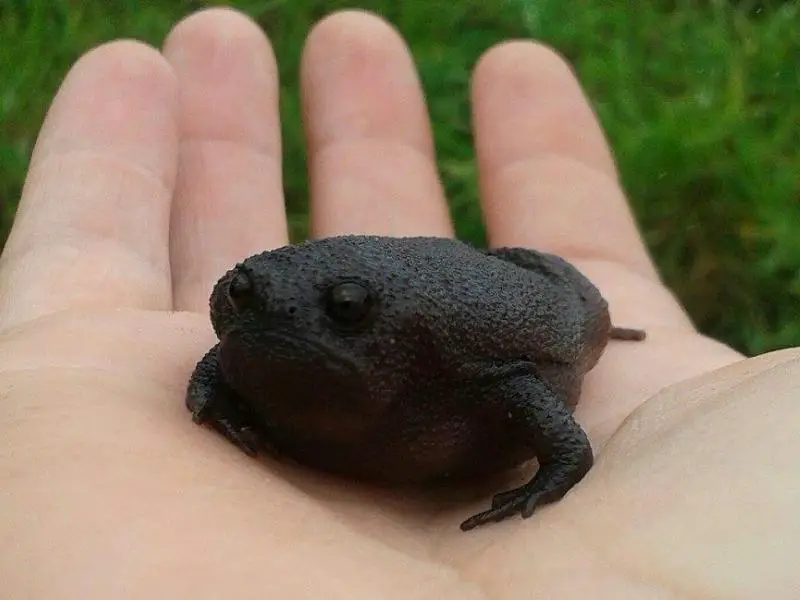
Black rain frogs are rare in the pet trade, so if you manage to keep one for yourself, it’s best to have an intermediate level of frog care knowledge. They’re not a suitable option as a first pet.
The trickiest part of caring for black rain frogs will be setting up a comfortable environment for the frogs to burrow.
Food and Water
Live insects are the main source of food for black rain frogs. They’re small frogs, reaching only 2 inches in size, so the insects they eat should be smaller than the distance between their eyes to prevent choking.
To avoid potential health issues, black rain frogs should consume a variety of insects. You can find larvae as well as a variety of feeder insects like spiders, ants, and red worms for sale online.
Crickets are a great source of protein, but if the crickets are larger than the frog, the frogs can suffer from impaction. Impaction is similar to constipation, where the frog experiences a blockage in their intestine that can lead to death if left untreated.
Black rain frogs should be fed 2–3 times per week, which is enough so there aren’t insects roaming around when the frog is done eating.
Never feed captive black rain frogs wild insects. Wild bugs can carry diseases and remnants of herbicides that can be harmful to frogs. Avoid toxic insects like stinkbugs and praying mantes as well.
Black rain frogs don’t need water to swim around in, so a small water bowl will suffice.
Handling
Handling a black rain frog can be done without physical concern since they’re not poisonous, but it’s important to be gentle.
Touching the frog will likely scare it, causing the frog to unleash its defense mechanism and puff up its body. If the frog is burrowed when this happens, it’s best to leave it alone. Trying to remove the frog from its burrow can cause undue stress.
Common Health Issues
Not much is known about health issues for the black rain frog in particular, but they are susceptible to a number of common infectious diseases of amphibians.
Diseases fall into four broad categories including bacterial, fungal, parasitic, and viral. Here is a couple to look out for:
- Ranavirus — is a DNA virus that causes frog virus-3 with a mortality rate above 90%. Symptoms to look out for include skin ulcerations and swelling of limbs. There is no treatment for ranavirus, and the frog should be quarantined from other pets.
- Chilomastixis — is a flagellate found in the intestine of frogs, typically caused by drinking water contaminated with feces. Dewormers can be used to treat intestinal parasites.
Breeding
Before mating black rain frogs in captivity, it’s important to understand their breeding process.
Unlike many other frog species, black rain frogs hatch from eggs as small frogs. Their usual breeding season is during summer, between the months of October and February.
Male black rain frogs emit a mating call that sounds like a quick chirp. Female frogs will secrete a sticky substance on their back that helps the male frog latch on for mating.
Once the frogs mate, the female creates a nest in her burrow and lays between 40–45 eggs per nest. The nest is covered with a decoy layer on top that’s filled with 20–30 empty eggs to confuse predators. Male frogs will guard the eggs until they hatch.
Breeding black rain frogs in captivity is possible, but they need adequate care and habitat conditions for mating to take place. Make sure you set up a comfortable enclosure and feed the frogs high-quality food to encourage the male and female frogs to breed, and if one of the frogs puffs out their body or screams, you should separate the male and female right away.
Choosing and Buying a Black Rain Frog
Black rain frogs are not readily available in the pet trade, so finding one for sale online or at a pet store is difficult.
They are only available in South Africa. The frogs are wild-caught by specialty frog breeders and sold at a premium, if at all. It’s unclear how much a black rain frog would cost to purchase. According to Scielo, the amphibian trade in South Africa isn’t booming, so don’t expect to see black rain frogs on the market any time soon.
Catching wild frogs comes with the risk of them carrying diseases and parasites. They’ll need a full veterinary evaluation before introducing them to a captive enclosure.

